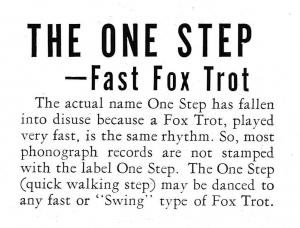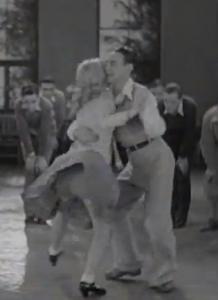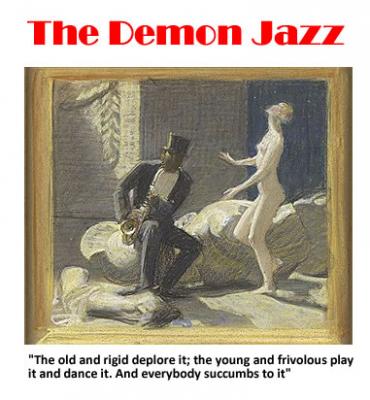- Historical Dance
- Jazz Age Social Dancing ("The Modern Dances")
- 0. The Essentials of Jazz Age Ballroom Dancing
- 1. Foxtrot Part 1: The Jazz Age Foxtrot
- 2. Youth Dancing in the Jazz Age
- 3. The Jazz Age Waltz
- 4. The Jazz Age Tango
- 5. 1930s Rumba
- 6. 1930s Samba
- 7. 1930s Conga
- 8. Bal Musette: Parisian Dance of the Jazz Age
- 9. Dancing in Weimar Berlin
- Dancing Made Easy - 1922
- Film Library - Jazz Age Dance
- Historical Dance Films posted to Pinterest
- Jazz Age Dance - Apologia
- Jazz Age Dance Image Collection
- Jazz Age Lead and Follow
- Places to Dance in Southern California in the Jazz Age
- Sampler of Jazz Age Dance Holds
- The Pathé Historical Dance Collection: 1920s-40s
- Ragtime Dance - the One Step
- Regency Dance
- Victorian Dance
- Jazz Age Social Dancing ("The Modern Dances")
Foxtrot Part 2: Hot Jazz Foxtrot (One-Step)
 Fox Trot is everything, and everything is Fox Trot
Fox Trot is everything, and everything is Fox Trot
"There was dancing now on the canvas in the garden; old men pushing young girls backward in eternal graceless circles, superior couples holding each other tortuously, fashionably, and keeping in the corners—and a great number of single girls dancing individualistically or relieving the orchestra for a moment of the burden of the banjo or the traps. By midnight the hilarity had increased"
The Great Gatsby
A quick disclaimer: I will be focusing on how fox trotters of all ages danced to the wild "Hot Jazz" rhythms of the Jazz Age. I won't be talking here about the frantic, more athletic dances favored by the young 'uns (More about youth dances). I will however, make the observation that the Fox Trot, defined as unstructured walking-dance with close contact, was pervasive. Most of the faddish dances had this as a foundation, with the dancers then breaking off to do their Charleston, their Collegiate Stomp, their Shag moves etc. and then going back into the Foxtrot embrace for a while - or not even breaking the embrace, but letting their feet go wild while their bodies remained in contact. All of these could be looked upon as Foxtrot variations. Foxtrot was the sea in which all Jazz Age dances swam.
The Jazz Age fast Fox Trot/One Step was a direct descendent of the One-Step of the turn of the 20th Century, when they hit on the revolutionary innovation of tossing out complex steps and just walking to any sort of music.(More about the Ragtime One-Step)
Some dance books of the day defined a One-Step as a walking dance where you stepped once on every beat, while a Fox Trot was a walking dance where you stepped on alternate beats or mixed your "quicks" and "slows". Outside the dancing school though, the term One-Step was seldom used, and the all-encompassing term Foxtrot was applied promiscuously.
This dance, as it has evolved to the present day, is now called the "Quickstep" though at the time that term seems to have been in use primarily in Britain, and since competitive ballroom dance originated there the term has thus found its way into our current dance vocabulary. I have even found (so far) one use of the term "Blue Trot" to refer to a piece that was not slow and sultry, as the term "Blues" would tend to suggest today, but rather bouncy and jazzy. In the '20s, "blues" usually meant an uptempo jazzy tune.
Dancers of our current time often identify this up tempo Foxtrot style as the "Peabody". There certainly was a dance or class of dances called "Peabody", going back as far as 1915, but it was not the all-encompassing term that one encounters today.
Folks in the 20s and 30s frequently called various flavors of the Jazzy Foxtrots by the name of some specific faddish signature variations that happened between the walking bits (e.g.the "Baltimore" shown below). The well known Charleston was frequently danced as a Foxtrot variation, either keeping the embrace and using more restrained steps, or separating from time to time to kick in all directions, do the bee's knees etc. and then returning to the closed Foxtrot.
 The underlying model of walk for a while, do a variation, then walk some more was the same for jazzy dances as it was for the smooth Foxtrot. The difference was one of spirit. With a jazzy tune, you step lively, put some bounce in your step and if you're really feelin' it, wiggle your your shoulders and shake your hips. The slow Foxtrot is smooth, gentle, perhaps a bit sentimental while the fast one is joyful, exuberant and unrestrained. They differ in mood but not in structure.
The underlying model of walk for a while, do a variation, then walk some more was the same for jazzy dances as it was for the smooth Foxtrot. The difference was one of spirit. With a jazzy tune, you step lively, put some bounce in your step and if you're really feelin' it, wiggle your your shoulders and shake your hips. The slow Foxtrot is smooth, gentle, perhaps a bit sentimental while the fast one is joyful, exuberant and unrestrained. They differ in mood but not in structure.
In these exuberant dances there were numerous exuberant solutions devised to the question of what to do when stuck in one place when the music was really fast. You were stationary on the floor but the Jazz was telling your feet to move! The Charleston "swizzle step" was one way, the "Shag" and "Balboa" were others, and there were many other fast-footed combinations learned or improvised. Some of these can be seen in the videos below.
The dance position in an uptempo dance could be exactly the same as in a slow Foxtrot (first photo), or it could be the "Collegiate" hold (second photo) where the partners kept their heads together (often cheek to cheek) but hunched over to pull their bodies a little apart and give their feet room to fly in all directions. (View a sampler of Jazz Age Dance Holds)
 The Two Step
The Two Step
This optional step-pattern variation can be done at any speed, but it is quite useful in up-tempo Foxtrots. It is simply thus (for the man): (1) step left, (2) bring the right up next to the left, (3) step left (4) bring right up by left but don't shift weight (5) step right (6) bring left up by right (7) step right (8) bring left up by right.
It's often stated as step-together-step-AND-step-together-step. If you already know the Polka step, this is it - just without the hop bounce.
This step is done in quick time, which is to say a step on every beat or slow time (step on every other beat) If the music is REALLY fast, "slow time" can still be quite fast. It can be done as a traveling step with a shade left, shade right pattern, as a time step in place or as a polka-like spin (think smooth polka, without the hop).
It can be danced with the feet forward or with them turned out (each gives a different flavor) or with a slight kick on the second step.
The timing is also the foundation of a lot of other steps which are, essentially, left-left right-right (e.g. Charleston swizzle step).
The overall effect of close contact with the upper bodies still while the feet move at high speed is, of course, very evocative of the Balboa and Shag, and their roots in the Jazz Foxtrot are clear to see.
It's also indicative of the fact that the distinction between a Jazzy Foxtrot and the youth dances is not a clear bright line. Dancers moved seamlessly from Foxtrot to Charleston or to Shag or Balboa and back again as the mood struck them. They were not constrained by the nomenclature, rigid definitions or structured routines that we so often focus on today. They were just dancing and making it up as they went along.
In this first of these videos, you see a private party of young people dancing the One-Step/Fox Trot to a lively jazz number (it was silent so I chose the music).
In the second, there's a set of variations called "The Baltimore" that should give a sense of how to Jazz up your dancing. Don't worry if you can't master all these variations, just focus on how the dancers move to the music. If you move in a roughly similar way, and throw in what ever variations you can manage, you'll do just fine. Also, since these are professionals putting on a demonstration, there are a lot more variations, coming at a higher frequency than you would be likely to see on a real-world dance floor. Don't feel like you are compelled to throw in a different variation every 2-4 bars.
Then there is a Pathe News clip called "The Hot Fox", with some fast-footed dancing by folks in evening clothes.
After that is a clip from a 1928 film showing a dance hall where standard Foxtrotters are sharing a floor with kids doing what would be called the "Shag" (though I think, at that moment, is was generally just called "Collegiate")
Next is the "Shimmie" from 1920, which looks like, essentially, a very fast-footed two-step.
Following that is a a bit of Jazz Age dirty dancing (what might be called a Bunny-Hug) from Joan Crawford.
These videos do not constitute the anywhere near the entire spectrum of jazzy dance. The variations are infinite and what ever you invent, if it actually seems to work, was probably also invented by someone back then so I suggest you just do it and enjoy yourself. Just remember, if the spirit moves you to kick, be mindful of the shins, ankles and insteps of your fellow dancers.
This shows several variations including the "Baltimore" step which, if you're having trouble following it, is, moving to the man's left: slide left, together, slide left, together (4 steps) pivot twice (four steps).
The "Hot Fox" from 1936. A fast-footed blend of Foxtrot and Charleston. They claim it was "The rage of Paris", but I doubt it was anything more that one of many jazzy variations.
A clip from the 1928 movie "Dance Hall", showing dancers doing the Shag sharing the floor with Foxtrot/One-Step dancers.
From the 1920 Film: "The Eastern Westerner", a bit of the Shimmy
This is a clip of Joan Crawford from "Rain" doing a naughty Fox Trot - a bit of Jazz Age dirty dancing.
